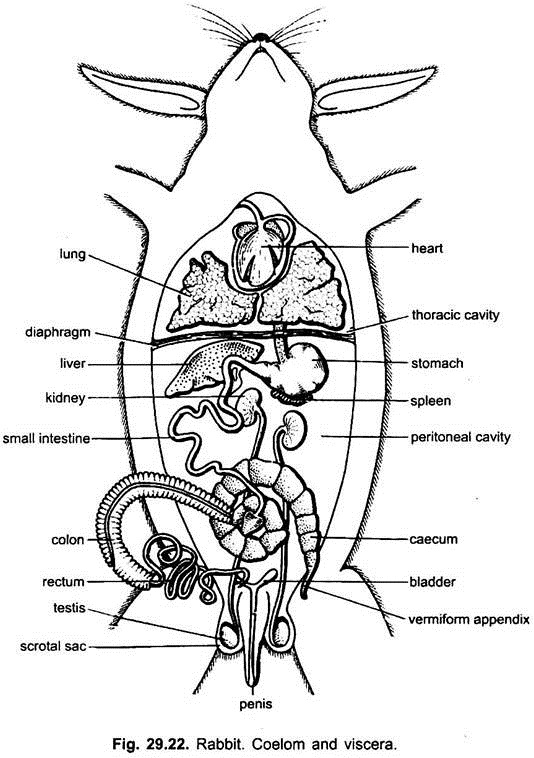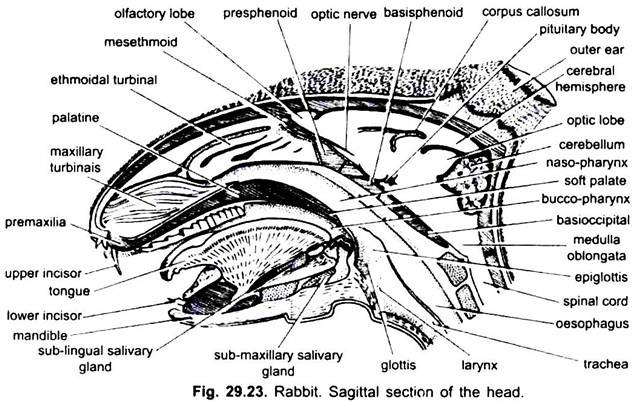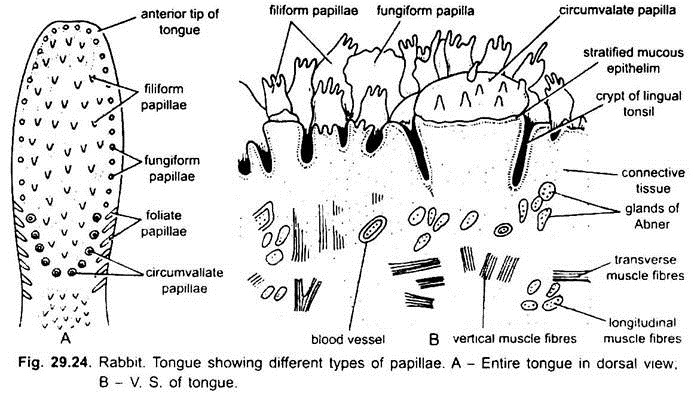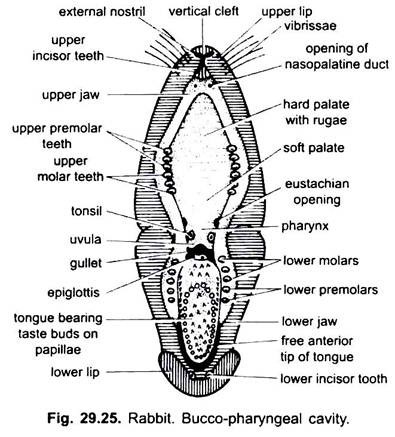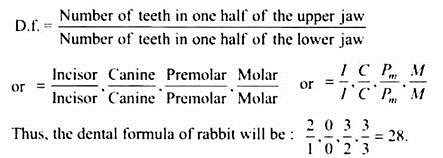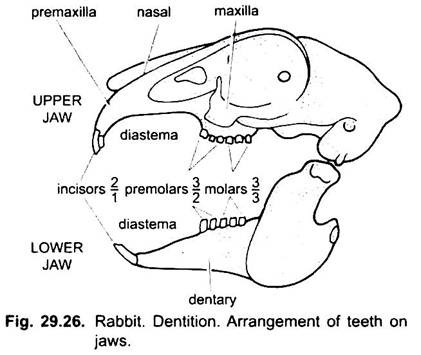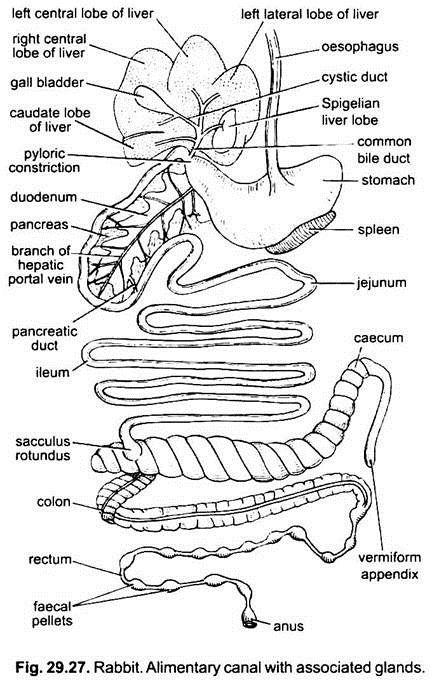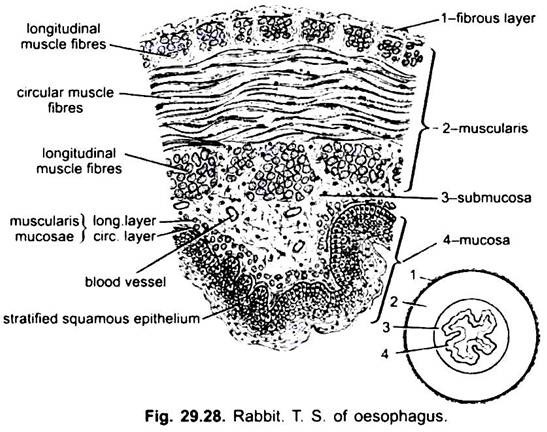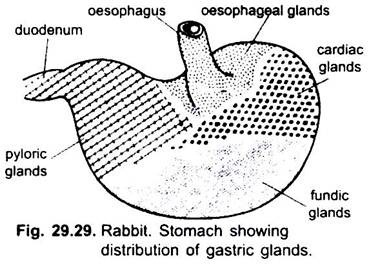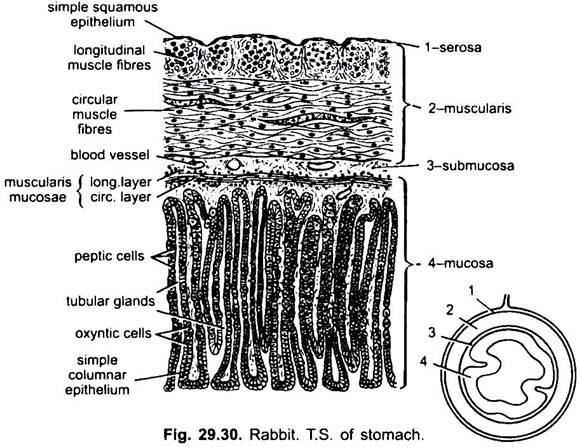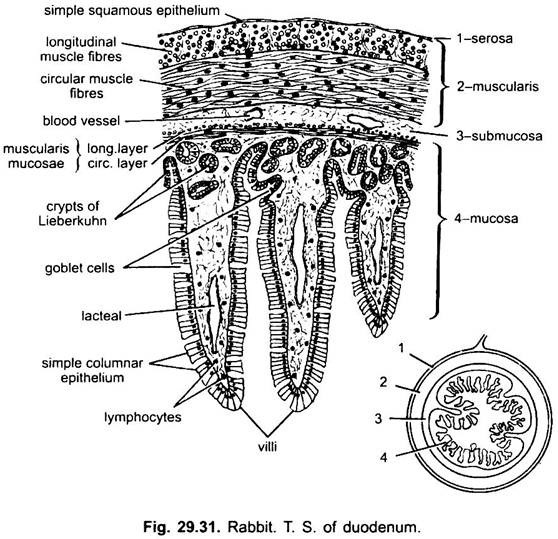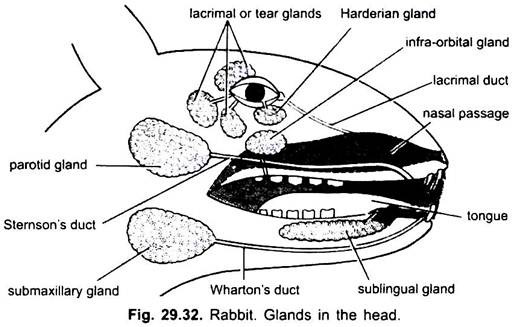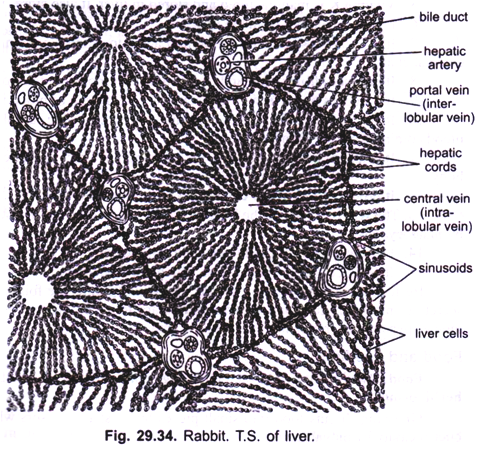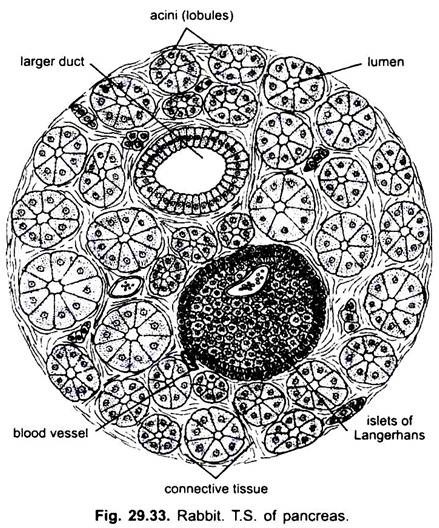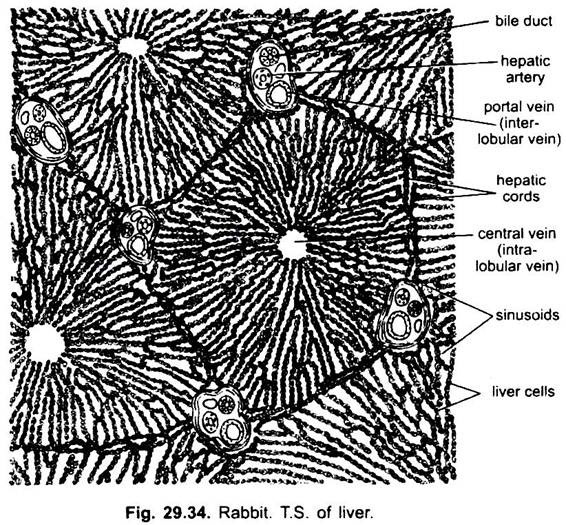The digestive system of the rabbit consists of the alimentary canal and the digestive glands associated with the alimentary canal.
Alimentary Canal:
The alimentary canal of rabbit is a long coiled tube of variable diameter starting from mouth and terminatings at anus. It consists of mouth, vestibule, pharynx (forming bucco-pharyngeal cavity), oesophagus, stomach, small intestine, caecum, large intestine and anus.
Bucco-Pharyngeal Cavity:
1. Mouth:
ADVERTISEMENTS:
The mouth is a transverse slit-like terminal aperture situated a little below the anterior tip of snout. The mouth is bounded by two soft mobile and muscular lips. These are externally covered by a hairy skin and internally lined with mucous membrane. The upper lip is divided by a median cleft extending up to the nostrils. Through this cleft the upper incisors remain exposed outwardly even when mouth is closed.
2. Vestibule:
The mouth opens into a narrow vertical space, called the vestibule, present in between lips and cheeks and gums of the jaws. Its mucous membrane contains mucous secreting glands.
3. Buccal Cavity:
ADVERTISEMENTS:
The vestibule opens into a large spacious buccal cavity in between the jaws. It is lined by the mucous membrane and contains the palate, tongue and teeth.
(i) Palate:
It forms the roof of buccal cavity. The anterior end of the palate is hard, supported by the premaxillae, maxillae and palatine bones forming the hard palate. The mucous membrane lining the palate (ectodermal in origin) forms transverse ridge, known as palatal rugae.
The posterior end of the palate is soft, smooth, fleshy and formed of connective tissue, called soft palate. The soft palate posteriorly hangs down freely into pharynx as a small flap, the uvula. The palate divides the original buccal cavity into a dorsal nasal passage and ventral food passage.
ADVERTISEMENTS:
The separation of the buccal cavity from the nasal passage by the palate enables the rabbits to retain their food in the mouth during chewing and to breathe at the same time. There is no clear cut demarcation between the buccal cavity and the pharynx, therefore, both these structures are considered together as buccopharyngeal cavity.
There is a pair of small openings of naso-palatine ducts in the anterior part of hard palate, which lead into the nasal or olfactory cavities. A tubular Jacobson’s organ opens into each naso-palatine duct whose function is probably to recognise different kinds of food. These are enclosed in a cartilage and situated on the floor of the nasal cavities.
(ii) Tongue:
The tongue is situated on the floor of the buccal cavity and the greater part of its length is attached to the floor of the buccal cavity with a free rounded tip in front. It is a fleshy, muscular and movable organ.The tongue is covered with mucous membrane beset with numerous papillae. On certain papillae are situated the taste buds.
On the basis of shape and size, these papillae are of four types:
(i) Fungiform, which are numerous mushroom-shaped situated at the margins of the tongue,
(ii) Filiform, which are numerous filamentous, situated at the upper surface of the tongue,
(iii) Circumvallate are large-sized, few in number situated at the base of the tongue, and
ADVERTISEMENTS:
(iv) Foliate are broad, leaf-like situated at the sides of the base of the tongue.
The function of the tongue is to manipulate the food and mixing of saliva with the food.
(iii) Teeth:
Both the jaws of rabbit bear teeth. These are situated on the premaxillae and maxillae of the upper jaw and dentary bones of the lower jaw. The teeth are situated in the cup-like sockets of the jaw bones, i.e., thecodont (L., theca = a case or sheath + G. odous = teeth) and are of different shapes, i.e., heterodont (Gr., heteros = different).
Teeth in rabbit are also diphyodont, i.e., two sets of teeth are seen during the lifetime of rabbit like majority of other mammals. The first set is known as milk-teeth which are deciduous in the young condition. The milk-teeth are replaced by the other set of permanent teeth in the adults which are not replaced.
Heterodont Dentition:
The teeth in mammals are four different types- incisors, canines, premolars and molars. All of these are with characteristic shape, definite position and function. Their number is also definite and fixed in every mammal. In rabbit only three types of teeth are found, because canines are absent.
Each half of the upper jaw of rabbit has two long, sharp and chisel-shaped incisors borne by premaxillae, while each half of the lower jaw has a single incisor at the tip of dentary. These are used for gnawing or cutting the food. The incisors of rabbit grow throughout life because they are open-rooted.
As there are no canines in both the jaws, a large gap called diastema is found between the incisors and cheek-teeth. The cheek-teeth, premolars and molars are alike with broad crown having sharp transverse ridges used for grinding the food. So they are also known as grinders. Such types of cheek-teeth are known as lophodont. Each half of the upper jaw has three premolars and three molars, while in the lower jaw only two premolars and three molars are found.
The number of each type of teeth of a mammal (dentition) is expressed by a dental formula.
The dental formula is expressed as the number of different types of teeth in one half of the upper jaw and is written above a line, while the number of teeth of one half of lower jaw is written below the line, e.g.:
Structure of Teeth:
The teeth are formed from the epidermis and dermis both. A typical tooth can be divided into three parts- crown, neck and root. Crown is the visible shining part of the tooth and projects out from the gum and out of the jaw bone. Neck lies below the crown in the gum. Root is embedded in a socket of the jaw bones.
A vascular periodontal membrane is found between the root and the socket. It is formed of connective tissue fibres (Sharpey fibres) which run from cement layer of root to bone. The bulk of the tooth is formed by hard dentine (dermal bony substance). In the crown it is covered over by a thin, hard and shining enamel layer. It is not found over root.
Inside the tooth a pulp cavity is found which contains connective tissue, blood vessels and nerves. The pulp cavity is lined by a layer of odontoblast or bone cells. The dentine is pierced by many fine canaliculi in which the protoplasmic processes of odontoblasts run. Further, the attachment of teeth on the jaw bones is strengthened by the gum.
Furthermore, the teeth are of two types- open rooted and close rooted. In the incisors of rodents, lagomorphs and elephants, pulp cavity is basally opened so these teeth grow continuously throughout life, and are called open rooted. In close rooted the basal aperture of pulp cavity becomes closed at a certain age, due to which teeth could not get nourishment and, thus, further growth ceases.
4. Pharynx:
The buccal cavity indistinguishably merges posteriorly into the pharynx which is small and narrow cavity.
The soft palate divides the pharynx incompletely into three parts:
(i) Nasopharynx is dorsal to the soft palate,
(ii) Oropharynx beneath the soft palate, and
(iii) Laryngopharynx around the freely suspended uvula or velum palati.
It communicates with the first two cavities. The nasopharynx communicates anteriorly with the nasal chambers through internal nares.
It has also a pair of oval eustachian openings on lateral sides. Eustachian openings lead to the tympanic cavities through the eustachian tubes. Just behind the tongue, the floor of laryngopharynx contains a median vertical slit-like glottis, which leads into larynx.
The glottis is guarded by a thin, bilobed cartilaginous flap called epiglottis. It develops from its anterior margin. When the animal swallows the food, the soft palate closes the internal nares and the epiglottis closes the glottis, so that the food passes into the oesophagus and never into the trachea. The laryngopharynx opens behind into the oesophagus through a wide gullet.
5. Oesophagus:
It is a long, narrow, distensible muscular tube. The oesophagus is joined by mucus secreting goblet cells, the secretion of which smoothens the oesophageal passage The oesophagus passes through the neck dorsally and parallel to trachea and passes through thoracic cavity dorsal to heart and lungs.
It then pierces the diaphragm to open into a sac-like stomach located in the abdomen. The inner wall of oesophagus is elevated into a number of longitudinal folds. Oesophagus acts as an organ of conducting the food and no digestion occurs here.
Histologically, the oesophagus is formed of four layers which are found throughout the alimentary canal. These from outer side are- serosa, muscular coat, submucosa and mucosa.
The outer layer or serosa is the thin fibrous layer which is absent in the upper part of oesophagus because it lies outside the coelom. It is only covered by a thin layer of fibrous connective tissue the tunica adventitia. Beneath it lies a thick muscularis layer. The muscularis layer is formed of outer longitudinal muscle layer and inner thick layer of circular muscles.
In the upper half of oesophagus the muscle fibres are of striped type and the lower half contains the unstriped type. The muscularis layer is followed by a submucosa layer. It is a connective tissue layer having blood vessels, lymphatics and nerves. It also supports plexus of Meissner composed of nerve cells and fibres. The submucosa is followed by a mucosa layer which is mainly formed of stratified equamous epithelium.
It is formed of three layers:
(i) Innermost stratified squamous epithelium,
(ii) Lamina propria (corium) is a thin layer of loose connective tissue having blood capillaries lymph vessels and nerves. It is projected into the epithelium, and
(iii) Muscularis mucosae is a narrow layer of inner circular and outer longitudinal smooth muscle fibres. It separates mucosa from submucosa.
6. Stomach:
The stomach is a large, curved sac-like structure situated behind the diaphragm slightly towards the left side in the abdominal cavity. The stomach is differentiated into three regions an anterior large broad cardiac region into which oesophagus opens, a narrow posterior pyloric region which leads into the duodenum and the third part is situated in between cardiac and pyloric regions, called fundic region.
A muscular sphincter or cardiac valve is present at the opening of the oesophagus in cardiac region which prevents the backward passage of food from stomach to oesophagus. Similarly a circular pyloric sphincter is present at the opening of pyloric stomach into duodenum called pylorus. It prevents the backward movement of food from duodenum to pyloric stomach.
The end of pyloric stomach is externally marked by a circular groove, the pyloric constriction. The cardiac and pyloric openings are near to each other. Near the outer curve of stomach is present a red elongated spleen. The function of stomach is to store food, churning of food and partial digestion of food.
Histologically, the stomach has the same construction as the oesophagus and is formed of outer serosa, muscularis, submucosa and mucosa layers. The distinguishing features of stomach are- The muscularis mucosae layer is not well developed.
The inner mucous membrane lining is well developed and thrown out into large number of folds and equal number of alternating deep gastric pits, into the bases of which open the ducts of long tubular simple or branched gastric glands.
These are of three types:
(i) Gastric glands of the cardiac region, called cardiac glands, contain only mucus secreting cells.
(ii) Gastric glands of the pyloric region, called pyloric glands, also produce mucus only.
(iii) Gastric glands of the fundic region, called fundic glands, contain-
(a) mucous secreting cells,
(b) zymogen cells or propepsin,
(c) prorenin secreting cells and
(d) oxyntic cells or hydrochloric acid producing cells.
The fundic region of the stomach opens in the intestine. In stomach villi are absent. Submucosa is like that of oesophagus. Muscular coat is well developed and has three layers: inner oblique muscles, middle circular muscles and outer longitudinal muscles. Outermost layer of stomach is serosa formed by single layer of simple squamous cells.
7. Intestine:
The intestine of the rabbit is very much coiled and long, nearly 1.2 metres in length, and can be divided into small and large intestines.
(i) Small Intestine:
It is formed of the following parts:
(a) Duodenum:
The first part of the small intestine is the duodenum which runs backwards, then turns in front forming a U-shaped loop. In the loop of the duodenum a pinkish diffused structure is found which is known as pancreas. The pancreatic duct from the pancreas opens in the proximal part of distal limb of the duodenum and the bile duct opens in the proximal limb. In the wall of intestine are present intestinal glands (crypts of Lieberkuhn) and branched Brunner’s glands.
Histologically, the duodenum is also formed of four layers, outermost serosa, mucularis, submucosa and mucosa. Submucosa layer contains branched glands, called Brunner’s glands, which produce mucous to protect the stomach lining from acid. These are characteristic of duodenum and not found in other parts of small intestine. Mucus secreted by these glands discharged into crypts of Lieberkuhn.
Crypts possess Paneth and argentaffin cells which secrete digestive enzymes. Crypts of Lieberkuhn are pocket-like structures between the villi. Muscularis mucosae of mucosa is reduced. Mucosa layer is formed of columnal cells and contains goblet cells which secrete mucus. Muscular layer has no oblique muscle fibres. Circular muscle layer is thicker than the longitudinal muscle layer.
(b) Jejunum and Ileum:
The duodenum passes into the jejunum and the ileum. There is no morphological difference between the two. Both are tubular, highly coiled measuring about seven to eight feet in length and it fills the major part of the abdominal cavity. Oval, granular Peyer’s patches are found at intervals along the whole length of the ileum which are areas of lymphoid tissue.
Jejunum and ileum are held with abdominal wall by fan-shaped folds of mesenteries. Their inner lining is elevated into a number of small finger-like process, called the villi. These increase the inner absorptive surface. The elevations of submucosa, villi and crypts of Lieberkuhn (intestinal glands) are larger in jejunum than the ileum.
Histologically, the ileum resembles with the duodenum. The mucosa of the ileum is thrown out into large number of finger-like folds, the villi, which are less in ileum, while more and taller in jejunum. Villi in jejunum are tongue-shaped with swollen ends. Only crypts of Lieberkuhn are present in ileum, and Brunner’s glands are absent. Lamina propria of mucosa has yellowish, oval, granular masses, called Peyer’s patches (lymph nodules). These produce lymphocytes. Crypts of Lieberkuhn are lined by columnar cells and goblet cells.
The ileum before opening into the large intestine dilates to form a round sacculus rotundus which opens into the caecum. The sacculus rotundus has an ileo-caecal valve by which the contents of the ileum can be directed into the caecum before passing into the colon.
Caecum:
It is found at the junction of ileum and colon. It is a thin-walled tube, about 50 cm long. Its external surface shows spiral constrictions. The caecum leads into a blindly ending fingerlike narrow tube, about 15 cm long and thick-walled, known as vermiform appendix. Cellulose is digested within the caecum by the action of bacteria.
(ii) Large Intestine:
The large intestine proceeds from the junction of caecum and sacculus rotundus. The opening of the caecum into the large intestine is much wider. The large intestine can be divided into two parts, a colon and the rectum.
(a) Colon:
The colon is the first part of large intestine which is about 45 cm long and bears longitudinal muscle bands, the taeniae. The wall of the colon is constricted at the sides of the taeniae at regular intervals to form pocket-like pouches, the haustra.
(b) Rectum:
The rectum is about 75 cm long and at intervals it is swollen to form rounded bead-like structures and finally opens outside by the anus. The inner wall of the large intestine is devoid of villi but there are small folds containing glands of Lieberkuhn and many mucous secreting goblet cells. Mucosa is formed of stratified epithelium near anus.
Muscularis mucosae and muscular layer are thicker than in colon. Muscle fibres are of striated type. Villi and Brunner’s glands are absent in large intestine. Crypts of Lieberkuhn are present, formed by the invagination of mucous membrane. Peyer’s patches are present in colon and projected into submucosa. Muscularis mucosae and muscular layers are thin in colon.
Anus:
It is the external opening of rectum located at the base of tail. Anus is guarded by anal sphincter.
Digestive Glands:
In addition to the glands found in the wall of the alimentary canal, there are certain other glands outside it but in its close association that produce secretions essential for the process of digestion. These glands are the salivary glands, pancreas and liver.
1. Salivary Glands:
Four pairs of salivary glands are found around the buccal cavity that open in it by their salivary ducts. In addition to the salivary glands, mucous glands are also found on the palate and tongue.
The various salivary glands of rabbit on the basis of their position are as follows:
(i) Parotid Glands:
These glands are situated at the base of pinnae and their long fine ducts open behind the upper incisors.
(ii) Infra-Orbital Glands:
These glands are situated below the orbits and their ducts open near the upper molars.
(iii) Submandibular or Submaxillary Glands:
These glands are situated on the inner side of the angles of lower jaws. Their long ducts open behind the lower incisors.
(iv) Sub-Lingual Glands:
These glands are situated below the tongue. Their several short ducts open below the free part or tip of the tongue.
Saliva is watery, alkaline and secreted by these glands, which contain slippery mucin and watery enzyme ptyalin. The mucin lubricates the food and the food-passage, while ptyalin helps in the digestion of starch in the form of maltose. The salivary glands are stimulated to produce saliva by reflex actions caused due to the presence of food in the buccal cavity.
2. Pancreas:
It is an irregular, pinkish gland situated in ‘U’-shaped duodenum supported by mesentery. Its duct opens into the distal limb of duodenum. Histologically, it consists of a large number of branching tubules, called acini, embedded in connective tissue containing blood and lymph vessels, nerves and pancreatic ductules.
The acinus is formed of cuboidal epithelial cells around a narrow lumen. These secrete the pancreatic juice consisting of several enzymes like trypsinogen, amylase and lipase, which act on proteins, starches and lipids respectively. The small ducts arising from the acini unite together to form a common pancreatic duct, which opens at the distal end of duodenum.
Several groups of cells, called islets of Langerhans, are found situated in between the acini of pancreas constituting an endocrine gland. Their secretion is a hormone, called insulin, produced by beta cells, which plays an important role in the metabolism of carbohydrates.
It regulates the amount of sugar in blood. The deficiency of insulin causes a disease, called diabetes. Alpha cells of islets of Langerhans secrete glucagon hormone which increases the concentration of glucose in blood. Its deficiency causes hypoglycemia.
3. Liver:
The liver is the largest gland of the body and remains attached to the posterior concavity of diaphragm by a fold of peritoneum, called faciparum ligament. It consists of five lobes, three are on the left and two on the right sides.
The left lobes are left lateral, left central and a Spigelian lobe, while the right lobes are right central or cystic and caudate lobe. The gall bladder is a large saccular thin-walled and dark green structure, situated in a groove on the posterior surface of right central lobe.
A large cystic duct arises from the gall bladder which receives several small hepatic ducts (equal to the number of lobes) from the different lobes of the liver carrying bile to the gall bladder, where it is stored and condensed. Thus, a large common bile duct is formed which opens in the proximal limb of the duodenum near pylorus guarded by sphincter.
Histological Structure:
Liver is a spongy, racemose type of structure. It is externally covered by a fibro-elastic serous coat (liver capsule). Each lobe of liver consists of a number of hepatic lobules separated from one another by a thin layer of connective tissue called septa or Glisson’s capsule but the separation of hepatic lobules in rabbit and man is incomplete.
But in pig’s liver it is complete. Each lobule is polygonal and consists of a mass of polyhedral hepatic cells arranged in radial rows, called the hepatic cords, around a central or intralobular vein. Radial rows of hepatic cells are 1 or 2 cells thick and anastomosing. Liver cells contain fine granular cytoplasm, large central nuclei and deposits of fat and glycogen.
Between the hepatic cords are present narrow irregular spaces, the lacunae, through which run blood capillaries, hepatic sinusoids having broken walls of endothelial cells. Hepatic sinusoids are formed from interlobular branches of hepatic portal vein and hepatic artery. Sinusoids empty into the intralobular veins which unite to form the hepatic vein.
Some specialised Kupffer cells are also found amongst liver cells which generally help in the destruction of many germs. At the corners of the adjacent lobules is found the interlobular blood vessels (branch of hepatic artery and hepatic portal vein), while the intralobular blood vessels are lying in the centre of the lobules. Interlobular blood vessels and bile duct lie within interlobular connective tissue called the portal areas or canals.
The intercellular spaces are left in between the heptic cells which receive the secretions of these cells, the bile. A number of such spaces unite together to form many interlobular bile ductules ultimately uniting together to form hepatic ducts which open in the common bile duct.
Functions of Liver:
The important functions of liver can be summarised as below:
1. It secretes bile which is an alkaline dark green coloured fluid, having several organic and inorganic salts (bile salts), bile pigments, cholesterol, lecithin, water as well as some waste substances.
The bile performs following functions:
(i) It makes the chyme alkaline better suited for the action of pancreatic juice.
(ii) It is responsible for the emulsification of fats.
(iii) It helps in removing the excretory products like bile pigments, inorganic salts, toxins etc., from the body.
(iv) It stimulates peristalsis.
(v) Some bile salts are necessary for the absorption of fat-soluble vitamin K and other vitamins soluble in fats.
(vi) Bile acts as an antiseptic, therefore, it does not allow the growth and multiplication of bacteria.
2. The excess of sugars are stored in the liver cells as glycogen by the process of glycogenesis.
3. It helps in maintaining a constant sugar level in the blood, i. e., at the time of need glycogen is converted into glucose (glycogenolysis).
4. It is a storage organ for the salts of iron and copper, and ribouncleoproteins.
5. Vitamin K is manufactured and stored in liver. It also stores vitamin D.
6. Lymph is formed from the liver.
7. It decomposes proteins and amino acids to ammonia from which urea is formed by a cyclical chain of reactions.
8. It produces fibrinogen and prothrombin responsible for clotting of blood.
9. It produces heparin which checks the coagulation of blood in the blood vessels.
10. It helps in removing various unwanted substances like carbolic acid, cresol, etc., from the blood coming from the alimentary canal.
11. It helps in changing amino-acids into albumin which regulate the salt-water balance in the body.
12. It produces red blood corpuscles in the foetus of mammals.
13. The Kupffer cells of the liver destroy the germs of many diseases and worn out RBCs & by phagocytosis.
14. It is the main heat producing centre of the body.
15. It produces certain substances which check anaemia.
Besides these three types of glands, intestinal glands are found in the mucosa of small villi secreting intestinal juice, and gastric glands are found in the mucosa of stomach which secrete mucus, pepsinogen, renin and hydrochloric acid
Food and Feeding:
Food:
The rabbit feeds on green vegetables, leaves of plants, roots, grasses, etc., i. e herbivorous.
Gnawing:
It cuts food into small pieces by its sharp incisors which are transferred into the buccal cavity by movable lips.
Mastication:
The food is masticated in the buccal cavity by premolar and molar teeth where saliva mixes with the food.
Swallowing:
Since saliva contains mucilaginous mucin which helps in lubricating and binding the masticated food into a food-bolus. The food-bolus is then swallowed into the oesophagus from where it passes into the stomach by peristaltic contractions. During swallowing the glottis is closed by the epiglottis and the nasal passage also becomes closed by the upward movement of soft palate.
Physiology of Digestion:
Digestion is the process of hydrolysis of complex foodstuffs into simpler soluble forms in which they can be absorbed. The hydrolysis occurs with the help of organic catalysts, called enzymes. The food generally contains proteins, fats, carbohydrates and inorganic salts, vitamins and water.
From these foodstuffs, proteins, fats and carbohydrates require digestion and the rest substances are more or less directly absorbed in the gastro-intestinal tract without undergoing the process of digestion. Digestion of food starts from the buccal cavity itself continues in the stomach and completed in the intestine.
1. Digestion of Food by Ptyalin in the Buccal Cavity:
As soon as food comes in the buccal cavity mastication occurs during which saliva from different salivary glands mixes with the food. Thus, during mastication the food is turned into a pulpy mass or bolus with the help of tongue and cheek muscles. The saliva contains largely water, mucin and an enzyme, ptyalin. Ptyalin acts on starch or polysaccharides turning them into compound sugars like maltose and dextrin. Mucin of the saliva lubricates the food and the food passage.
Starch + Ptyalin → Maltose and Dextrin.
The food in the form of bolus is swallowed with the help of tongue which pushes bolus behind and the pharyngeal muscles force it into the oesophagus which is known as deglutition. The epiglottis prevents it from entering into the larynx. Once the bolus comes in the oesophagus it is pushed into the stomach due to the wave of contraction (peristalsis) in oesophagus which is facilitated by the mucus secreted from the mucous glands of the oesophageal wall.
2. Digestion of Food by Pepsin in Stomach:
In the stomach food remains for a longer time. It is churned, broken into smaller fragments by the contraction of stomach muscles. It is also mixed with the gastric juice. A hormone, gastrin, secreted in the stomach stimulates the gastric glands to produce gastric juice which mixes with the food. The gastric juice contains nearly 90% water, 0.5% HCl, proenzymes like prorenin and propepsin and gastric lipase.
The Hydrochloric Acid:
(i) Checks bacterial decomposition of the food,
(ii) Stops the action of ptyalin on starch,
(iii) Brings the food in acidic medium,
(iv) Acts as an activator for the proenzymes-prorenin and propepsin, converting them into renin and pepsin respectively, and
(v) Stops contractions of the stomach. The renin is only found in the young rabbits.
The renin acts on milk protein casein in presence of Ca ions and converts it into curd which is calcium paracasein. The pepsin acts on proteins including calcium paracasein to change them into peptones and proteoses. The gastric lipase acts on fats to convert them into fatty acids and glycerol. The amount of gastric lipase is very less, therefore, it is a negligible reaction.
The presence of pyloric sphincter helps in retaining the food in the stomach for a longer time during which the food is churned and mixed thoroughly with the gastric juice until it takes the form of a semi-digested thick pasty solution, called chyme. The pyloric sphincter only opens when the chyme becomes acidic. The food in the form of chyme passes into the duodenum by the peristaltic contractions of the stomach wall.
3. Digestion of Food in Intestine:
Duodenum secretes a hormone, cholecystokinin, which stimulates gall bladder to pour bile-juice in the duodenum. Another hormone, secretin, is also produced in duodenum which stimulates pancreas to produce pancreatic-juice which is also poured in the duodenum.
At the same time from the glands of crypts of Lieberkuhn of duodenum and small intestine a juice called succus-entericus is produced. The chyme, thus, meets with the bile juice, pancreatic juice and juice from intestine, the succus-entericus, as soon as it comes in the duodenum.
(i) Bile-Juice:
It is an alkaline, dark green coloured fluid containing water, bile salts, and bile pigments. It has no digestive enzymes; therefore, it does not take part directly in digestion but plays an important role in the process of digestion.
(i) It contains important bile salts such as glycocholate and taurocholate of sodium and cholesterol,
(ii) Sodium glycocholate, taurocholate and cholesterol break down fats globules to form emulsion which can be easily acted upon by the enzymes of pancreas. Sodium bicarbonate neutralises the acid of chyme and makes it alkaline. This is essential because pancreatic juice and intestinal juice operate only in alkaline medium.
(iii) Bile juice also prevents putrefaction of the food.
(iv) The bile pigments present in the bile juice are biliverdin and bilirubin which are formed by the breakdown of haemoglobin of worn-out red blood corpuscles in the liver and are excretory waste products. The green colour of the bile juice is only due to the presence of these pigments and they are passed out with faeces as such.
(v) Bile salts also help in the absorption of fats and fat soluble vitamins – A, D and K.
(ii) Pancreatic Juice:
It is also an alkaline fluid containing largely water, proenzymes trypsinogen and chymotrypsinogen, and enzymes amylase, lipase, etc. (a) Trypsinogen is activated by the enterokinase of the succus entericus and converted into trypsin. Trypsin activates chymotrypsinogen to change into chymotrypsin. Trypsin and chymotrypsin are proteolytic enzymes acting upon peptones, proteoses and fresh remaining protein if any, to convert them into amino acids, (b) Amylase acts upon starch and glycogen to change them into the molecules of maltose, a disaccharide sugar, (c) Lipase acts on fatty emulsion formed by the bile and converts it into fatty acids and glycerol.
(iii) Succus Entericus:
It is also alkaline watery fluid containing an activator, enterokinase, and several enzymes like peptidases (proteolytic enzymes, e.g., erepsin), lipase, invertase, maltase and lactase, (a) Enterokinase activates pancreatic trypsinogen to trypsin. (b) The peptidases (erepsin) act on polypeptides to change them into amino-acids. (c) Lipase acts on remaining fat emulsion converting it into fatty acids and glycerol, (d) Maltase hydrolyses maltose to glucose, (e) Invertase and lactase act on sucrose and lactose respectively to change them into glucose.
Thus the digestion of various foodstuffs is completed and as the food passes through the intestine it receives more water and forms a fluid emulsion, called chyle, which is slowly pushed onwards by peristalsis. The enzymatic activity remains continuous throughout the process and finally the proteins, carbohydrates and fats are hydrolysed into amino-acids, glucose or similar monosaccharide sugars and fatty acids and glycerol respectively.
4. Digestion of Cellulose in Caecum:
The cellulose in the diet of rabbit (herbivores) remains undigested, for which it passes in the caecum. Thus, the digestion of cellulose occurs in the caecum which is well developed in rabbit and herbivorous mammals. Cellulose decomposing symbiotic bacteria and protozoans are found in the caecum, where it is decomposed to soluble sugars and bacteria in return get nitrogenous food. The process of digestion and absorption of cellulose is very slow therefore, food remains for a long time in the caecum.
However, only partial decomposition of cellulose has been reported so far in the case of rabbit. The digested foodstuffs are absorbed in the intestine and the remaining fluid content of the alimentary canal passes into the colan and rectum, where water is absorbed and semisolid faeces remains. Some putrefying bacteria of the colon help in the formation of faeces which passes out through the anus.
5. Coprophagy:
It has been observed that rabbit feeds on night excreta (coprophagy) which is moist and soft for the incomplete digestion of cellulose. Rabbit only feeds on the faeces produced during night. Thus, the decomposed and simplified cellulose in the excreta is again subjected to digestion during its passage through the gut.
The digested cellulose does not enter the caecum again but passes directly in the colon where water is absorbed and dry faecal pellets are formed. It has also been reported that if the rabbits are not allowed to feed on night excreta, they die soon. Faeces produced during the daytime are not eaten because it is dry and hard. The various minerals water and vitamins, etc., are directly absorbed more or less without undergoing the process of digestion.
Absorption:
The end products of digestion, e.g., amino acids, glucose, other monosaccharides, fatly acids and glycerol are absorbed in the intestinal wall (mainly in ileum) through the intestinal villi. The amino acids, glucose and other monosaccharides are easily absorbed in the blood capillaries of intestinal villi by simple process of diffusion.
They are finally carried to the liver through the portal circulation. The fatty acids and glycerol pass in the intestinal lacteals which are lymph capillaries in the intestinal villi. These are taken in the blood circulation through lymphatic system.
Recent electron microscopic studies have revealed that it is not necessary for fats to change into fatty acids and glycerol for being absorbed, because the fat globules coming in contact with the microvilli of the intestinal cells are passed directly through their cell membrane into the lymphatic capillaries of the villi.
Egestion or Defaecation:
After absorption of digested food in the ileum, the remaining undigested solid residue like vegetable fibres and cellulose, etc., enters the large intestine. Water is absorbed in the colon leaving the solid humid faeces. In the rectum, faeces are converted into small pellets which are periodically discarded through the anus.
Assimilation:
The absorbed amino-acids and monosaccharides first come into the liver through portal circulation and then go to the heart for circulation in the different parts of the body where tissues pick up their requirements. The amino acids are building material and constantly needed for the formation of protoplasm.
The excess of amino acids are subjected to the process of deamination in liver forming ammonia which is soon converted into urea, which is excreted by the kidneys. The excess of monosaccharides are stored in the form of glycogen usually in the liver cells.
Whenever glucose level falls down in the blood then glycogen is soon converted into glucose (glycogenolysis) to maintain its normal level in the blood. Liver is also concerned with fat metabolism and the fatty globules are found filled in the liver cells. Energy is also released from the fats. The fats are also converted into amino acids and carbohydrates by the liver.
